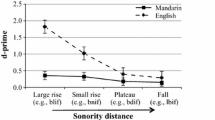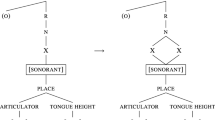Abstract
This paper reexamines syllable contraction in Taiwanese Southern Min. Grounded on Chung's (1996) autosegmental model, the current analysis is characterized by six points: (a) Every syllable has an XXX template. (b) Edge-in (Yip 1988) takes care of the association of edge consonants with edge skeletal slots. (c) The realization of the nucleus abides by the order of N-placement, rising diphthong formation, and falling diphthong formation. (d) The sonority hierarchy of a > O > e > o > i > u determines how vocoids are associated with the nucleus position. If there is a tie, the first segment gets linked by temporal sequence. V-neutralization (Chung 1996) turns mid vowels into high when they form rimes with the adjacent vowels. (e) The contracted form abides by Maximality (Prince 1985) to construct the largest possible syllable. (f) In addition, stress is shown irrelevant, and phonotactic constraints may be contravened.
Similar content being viewed by others
REFERENCES
Bao, Zhiming (2001) “Sub-syllabic Processes and the Southern Min Syllable,” in D.-B. Xu (ed.), Chinese Phonology in Generative Grammar, Academic Press, New York, pp. 95–116.
Chang, Yü-hung (1986) “The Status of Suprasegmentals and Other Syllabic 'Accessories' in Taiwanese Riming Schemes,” paper presented at the Second International Conference on Sinology, Taipei, December.
Chen, Hsiu-chi (2002) Taiwan Zhangzhou Kejia Hua Yanjiu - yi Zhaoan Hua wei Daibiao [Study of Zhangzhou Hakka in Taiwan - Represented by the Zhaoan Dialect], M.A. thesis, National Hsinchu Teachers College.
Chen, Zhangtai and Li Rulong (1991) Minyu Yanjiu [A Study of Min Dialects], Yuwen Chubanshe, Beijing.
Cheng, Robert (1985) “Sub-syllabic Morphemes in Taiwanese,” Journal of Chinese Linguistics 13.1, 12–43.
Chung, Raung-fu (1996) The Segmental Phonology of Southern Min in Taiwan, Crane Publishing Co., Ltd., Taipei.
Chung, Raung-fu (1997) “Syllable Contraction in Chinese,” in F. Tsao and S. Wang (eds.), Chinese Languages and Linguistics III: Morphology and Lexicon, Academia Sinica, Taipei, pp. 199–235.
Duanmu, San (1990) A Formal Study of Syllable, Tone, Stress and Domain in Chinese Languages, Ph.D. dissertation, MIT.
Duanmu, San (2000) The Phonology of Standard Chinese, Oxford University Press, New York.
Feng, Sheng-Li (1997) Interactions between Morphology, Syntax and Prosody in Chinese, Peking University Press, Beijing.
Goldsmith, John (1976) Autosegmental Phonology, Ph.D. dissertation, MIT (Published by Garland, New York, 1979).
Ho, Wen-Hwa (1994) “Tone in the Guangzhou Dialect [Gunagzhou Hua zhi Shengdiao,” Shengyun Luncong 2, The Student Book Co., Ltd., Taipei, pp. 423–440.
Hsiau, Yuchau E. (2002) “Tone Contraction,” paper presented at the Eighth International Symposium on Chinese Languages and Linguistics, Taipei, November.
Hsu, Hui-chuan (2001) “Syllable Contraction in Taiwanese Southern Min: A Sonority Approach,” in R. Rapp (ed.), Linguistics on the Way into the Third Millennium: Proceedings of the 34th Colloquium of Linguistics, Germersheim 1999, Part I: Text, Meaning, and Communication, Peter Lang, Frankfort, pp. 733–740.
Hsu, Hui-chuan (forthcoming) “On the Structure of /iu/ and /ui/ in Sixian Hakka,” Journal of Chinese Linguistics.
Katamba, Francis (1989) An Introduction to Phonology, Longman Publishing Co., London.
Kenstowicz, Michael (1994) Phonology in Generative Grammar, Blackwell Publishers, Cambridge.
Kiparsky, Paul (1979) “Metrical Structure Assignment Is Cyclic,” Linguistic Inquiry 10.3, 421–441.
Ladefoged, Peter (2001) A Course in Phonetics, Harcourt College Publishers, New York.
Levin, Juliette (1985) A Metrical Theory of Syllabicity, Ph.D. dissertation, MIT.
Li, Hsien-chang (1986) “Phonological Change in Southern Min [Fulao Hua de Yinyun Bianhua],” Taiwan Fengwu 36.3, 3–24.
Li, Paul Jen-kuei (1986) “Rhyming and Phonemic Contrast in Southern Min,” Bulletin of the Institute of History and Philology, Academia Sinica 57.3, 439–463.
Li, Rulong (2001) Fujian Xianshi Fangyan Shier Zhong [Twelve Dialects in Fujian], Fujian Jiaoyu Chubanshe, Fuzhou.
Lin, Hsiu-Hsu (1995) “Degenerating Syllables as a Cause of Contraction,” in S. Wang and F. Tsao (eds.), Proceedings of the Second International Conference on Languages in Taiwan, pp. 467–487.
Lin, Yen-Hwei (1989) Autosegmental Treatment of Segmental Processes in Chinese Phonology, Ph.D. dissertation, University of Texas, Austin.
Lin, Yen-Hwei (1999) “Dissimilation and the Concealment Function of Chinese Secret Languages,” in Y.-M. Yin, L. Yang, and H. Chan (eds.), Chinese Languages and Linguistics V: Interactions in Languages, Academia Sinica, Taipei, pp. 177–203.
Parker, Steven G. (2002) Quantifying the Sonority Hierarchy, Ph.D. dissertation, University of Massachusetts, Amherst.
Prince, Alan (1985) “Improving Tree Theory,” in M. Niepokuj et al. (eds.), Proceedings of the Berkeley Linguistic Society 11, pp. 471–490.
Prince, Alan and John Smolensky (1993) “Optimality Theory: Constraint Interaction in Generative Grammar,” ms., Rutgers University and University of Colorado, Boulder.
Roca, Iggy and Wyn Johnson (1999) A Course in Phonology, Blackwell Publishers, Cambridge.
Selkirk, Elizabeth O. (1984) “On the Major Class Features and Syllable Theory,” in M. Aronoff and R. Oehrle (eds.), Language Sound Structure, MIT Press, Cambridge.
Shih, Chi-Lin (1986) The Prosodic Domain of Tone Sandhi in Chinese, Ph.D. dissertation, University of California, San Diego.
Tseng, Chin-Chin (1999) “Contraction in Taiwanese: Synchronic Analysis and its Connection with Diachronic Change,” in Y.-M. Yin, L. Yang, and H. Chan (eds.), Chinese Languages and Linguistics V: Interactions in Languages, Academia Sinica, Taipei, pp. 205–232.
Wan, I-Ping (1999) Mandarin Phonology: Evidence from Speech Errors, Ph.D. dissertation, University of New York at Buffalo.
Wang, Mei-Yan (1993) The Edge-In Theory and Syllable Contraction in Southern Min, unfinished M.A. thesis, National Cheng-Kong University, Tainan.
Wang, Shi-Ping (1995) “Tone-segment Interaction: Notes on Simplification,” in F. Tsao and M. Tsai (eds.), Papers from the First International Conference on Languages in Taiwan, The Crane Publishing Co, Ltd., Taipei, pp. 487–512.
Yang, Hsiou-fang (1991) Manuscript of Syntax in Taiwanese Southern Min [Taiwan Minnan Yu Yufa Gao],” Daan Publisher, Ltd., Taipei.
Yip, Moira (1988) “Template Morphology and the Directionality of Association,” Natural Language and Linguistic Theory 6, pp. 551–577.
Yu, Shiou-min (1984) Aspects of the Phonology of Miaoli Hakka, M.A. thesis, Fu Jen Catholic University, Taipei.
Author information
Authors and Affiliations
Rights and permissions
About this article
Cite this article
Hsu, HC. A Sonority Model of Syllable Contraction in Taiwanese Southern Min. Journal of East Asian Linguistics 12, 349–377 (2003). https://doi.org/10.1023/A:1026108613211
Issue Date:
DOI: https://doi.org/10.1023/A:1026108613211




